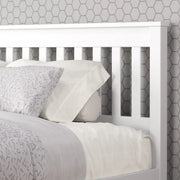
A good night’s sleep starts with selecting the best quality bed. Key factors such as comfort, durability, and support play a significant role in determining the perfect bed for your needs. Investing in a high-quality bed can greatly enhance your overall well-being and daily productivity.
Materials and construction are vital elements to consider. High-quality mattresses often feature advanced foam technology or robust coil systems. A strong bed frame made from sturdy wood or metal ensures the mattress is well-supported and adds to the bed's longevity.

Personal preferences vary, making it essential to understand the different types of beds available. Memory foam, innerspring, and hybrid beds each offer unique benefits. Finding the right type that matches your sleeping habits can make a substantial difference in comfort and satisfaction. Choose wisely to enjoy restful nights and energized days.
Understanding Mattress Types and Materials
Choosing the right mattress involves understanding the different types and materials available. Each type offers unique benefits and caters to various preferences and needs.
Memory Foam and Its Benefits
Memory foam mattresses are popular for their ability to contour to the body. They provide excellent pressure relief and support spinal alignment, which can be especially beneficial for individuals with back pain.
Memory foam tends to minimize motion transfer, making it ideal for couples. On warmer nights, some memory foam mattresses can retain heat, but advanced options now include cooling gel layers to mitigate this.
Innerspring Mattresses and Support
Innerspring mattresses, known for their coil-based construction, provide robust support. The springs come in different forms, including pocketed and continuous coils. Pocketed coils offer better motion isolation compared to other types.
The responsiveness and breathability of innerspring mattresses make them a favorite, and they tend to be more affordable. However, they may have a shorter lifespan compared to other materials.
The Rise of Hybrid Mattresses
Hybrid mattresses combine multiple materials, often featuring layers of foam and innersprings. This design aims to offer the best of both worlds—pressure relief and support.
Hybrids typically include memory foam or latex on top, providing comfort. Below that, innersprings add support and bounce. This blend can also improve airflow, addressing the heat retention issue common with foam-only mattresses.
Exploring Latex and Organic Mattresses
Latex mattresses are known for their durability and natural materials. They offer a balance of comfort and support, similar to memory foam but often with better breathability.
Natural latex is hypoallergenic and resistant to dust mites and mold. Organic mattresses use materials such as organic cotton or wool, appealing to eco-conscious consumers. They can be pricier but provide peace of mind regarding environmental impact.
Selecting the Right Mattress for You
Finding the best mattress involves considering factors like firmness, comfort, sleeping position, and specific needs for couples and side sleepers. Additionally, durability, warranty, and brand reputation play critical roles in making an informed decision.
Assessing Firmness and Comfort Levels
Firmness and comfort are subjective, varying from person to person. Firm mattresses often support back and stomach sleepers, while soft ones provide plush comfort to side sleepers. Medium-firm options may balance support and softness, appealing to a wider audience.
A firmness scale ranges from 1 (extra soft) to 10 (extra firm). Empirical testing by lying on different mattresses can help determine personal preference. Ensuring a return policy is key, as real-world testing over weeks can validate comfort levels.
Ideal Mattresses for Different Sleeping Positions

Sleeping positions dictate specific mattress needs. Back sleepers generally require medium-firm mattresses to support spinal alignment, while stomach sleepers benefit from firmer mattresses to prevent the spine from sagging.
Side sleepers need softer mattresses to cushion pressure points like shoulders and hips. Combination sleepers, those who switch positions, might prefer a medium-firm mattress that accommodates various postures. It’s about providing consistent support across a range of positions.
Important Considerations for Couples and Side Sleepers
Couples should prioritize motion isolation to minimize disturbances from partner movements. Mattresses with innerspring designs often transfer more motion, whereas memory foam and hybrid models excel in motion isolation.
Edge support is essential for couples who utilize the entire bed surface. High-density foam along the edges enhances stability. Side sleepers, prone to shoulder and hip discomfort, should look for pressure-relief features, like memory foam layers, to ensure comfort throughout the night.
Evaluating Durability, Warranty, and Brand Reputation
Durability ensures the mattress maintains its structure and support over time. High-density foams and robust coil systems signify higher durability. A substantial warranty period, often 10 years or more, reflects the manufacturer's confidence in their product.
Researching brand reputation involves reading customer reviews and expert opinions. Established brands are often more reliable, offering consistent quality and support. Checking for certifications, such as CertiPUR-US, guarantees safer materials, reinforcing trust in the purchase.










